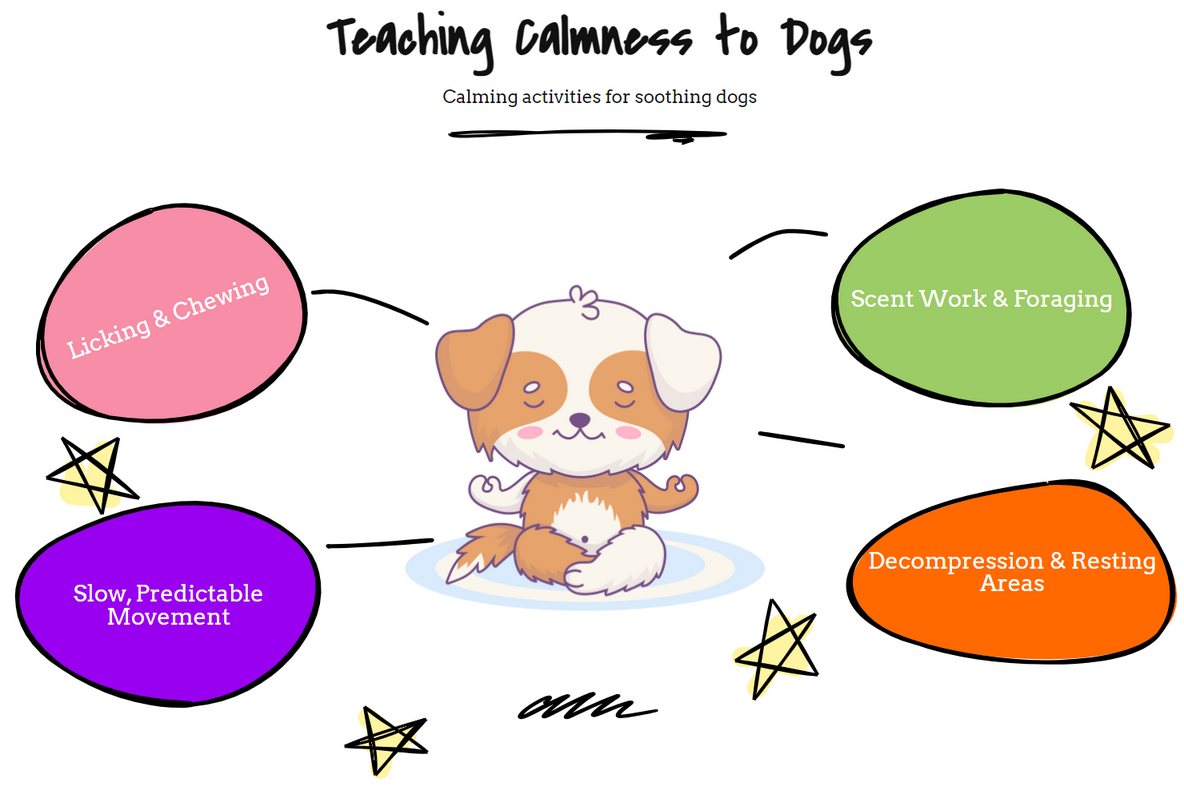Help Your Dog Relax with These Science-Backed Techniques
Does your dog struggle with over-excitement, anxiety, or restlessness?
Many times we focus on physical exercise to “tire out" our dogs,” but true emotional balance comes from engaging a dog’s mind and natural instincts in ways that promote calmness and self-regulation too.
At Canine Brain Games, we believe that enrichment isn’t just about keeping dogs busy—it’s about teaching them to relax, process their environment, and feel more secure. Below are science-backed enrichment activities that we use to help dogs develop calm behaviors naturally.

1. Licking & Chewing: The Power of Oral Soothing
Why It Works: Licking and chewing trigger the release of endorphins, the same feel-good chemicals that help us relax. This self-soothing behavior is an excellent way to help a dog decompress after excitement or stress.
How to Use This for Calmness:
✔ Lick Mats & Slow Feeders – Spread peanut butter, yogurt, or pumpkin onto a lick mat and freeze it for a long-lasting, calming activity.
✔ Frozen Treats – Stuff a Kong with a mix of soft food and freeze it to extend chewing time.
✔ Chew Items – Provide safe chews like bully sticks, Himalayan chews, or raw bones for oral enrichment.
Pro Tip: Offer licking or chewing activities in a quiet space before bedtime or after a walk to help your dog settle faster.
2. Scent Work & Foraging: Sniffing Lowers Stress
Why It Works: Sniffing has been scientifically proven to reduce cortisol levels (the stress hormone) in dogs. Allowing dogs to engage their nose helps them focus, relax, and feel more in control of their environment.
How to Use This for Calmness:
✔ Scatter Feeding – Instead of feeding from a bowl, sprinkle kibble in the grass, a snuffle mat, or a towel for your dog to find.
✔ Snuffle Mats – Hide treats in a snuffle mat or rolled up towel and encourage your dog to sniff them out.
✔ Simple Nose Work Games – Place a treat in one hand and let your dog use their nose to find it.
Pro Tip: Start with easy scent games and gradually increase the challenge by hiding treats in harder-to-find spots.
3. Slow, Predictable Movement: Teaching Relaxation Through Guided Activity
Why It Works: Dogs often mirror our energy, so if we use slow, structured movements, it encourages them to settle. This technique helps with impulse control and emotional regulation.
How to Use This for Calmness:
✔ Sniffari Walks – Use a long leash and allow your dog to walk slowly and explore at their own pace, focusing on sniffing instead of constant movement.
✔ Guided Relaxation Touch – Lightly stroke your dog with long, slow movements, watching for signs of relaxation (soft eyes, deep sighs).
✔ Mat Work – Having your dog learn to relax on a plaform like a raised bed or even a towel is a great way to teach and reinforce calmness.
Pro Tip: Avoid high-energy play before bedtime and instead use slow movement activities to encourage natural relaxation.
4. Decompression & Safe Resting Areas: Giving Your Dog a Calm Retreat
Why It Works: Just like humans, dogs need quiet spaces to relax and feel secure. Having multiple dedicated calm areas can help your dog disengage from stress and reset their nervous system.
How to Use This for Calmness:
✔ Create a Safe Space – Set up a cozy, quiet area with a soft bed, low lighting, and familiar scents.
✔ Teach a Relaxation Mat Cue – Encourage your dog to settle on a mat or bed using treats and soft praise.
✔ Play Calming Sounds – Try classical music or white noise. A lavendar scented toy to help promote relaxation.
Pro Tip: Use this space after enrichment activities to allow your dog to wind down naturally.
Enrichment for a Calm, Happy Dog
Helping your dog learn to relax is just as important as physical exercise. By incorporating these simple enrichment activities, you can teach your dog to self-regulate, build confidence, and naturally settle in a variety of environments.
Try This Challenge: Pick one of these calming enrichment activities to introduce today. Observe how your dog responds and adjust based on their preferences!
At Canine Brain Games, we’re passionate about helping dog guardians find practical, science-backed enrichment strategies that lead to happier, calmer, and more engaged dogs.

